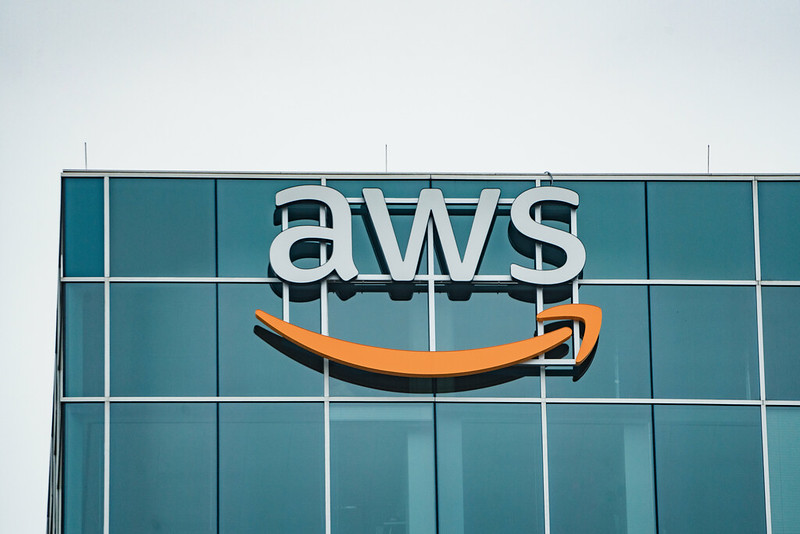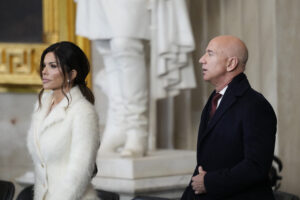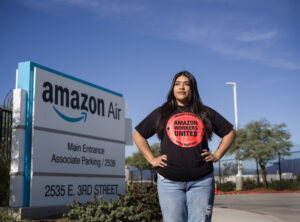Sanders Calls for Investigation Into Amazon’s Labor Abuses
New records uncovered by The Center for Investigative Reporting lay bare the true toll of Amazon's desperate drive for speed. Updated Tony Webster / Flickr
Tony Webster / Flickr
Update: On Wednesday, Sen. Bernie Sanders released this statement in response to the below story, written by Will Evans at Reveal, about Amazon’s labor abuses:
“Greed, in my view, is like a sickness. It is like an addiction. How else do you explain the mindset of Amazon, one of the wealthiest companies on the planet, run by Jeff Bezos, the wealthiest person on earth? The only thing these people care about is making more profit—they don’t give a damn if that means deliberately harming the human beings who work in their warehouses.
“It is unconscionable that in 2019, these Amazon warehouse workers are exposed to unrelenting physical demands, hazardous conditions, and even surveillance. And then, as they’re coping with serious work injuries, Amazon is working to conceal that information.
“I am demanding that the Department of Labor immediately investigate this rampant abuse. The American people will not stand for the obscenity of seeing Amazon warehouse workers die on the job and suffer injuries at double the levels of the rest of the industry, all just to line the pockets of Bezos and his rich friends.”
The original story follows below; it was produced by Reveal from The Center for Investigative Reporting, a nonprofit news organization. Get their investigations emailed to you directly by signing up at revealnews.org/newsletter.
When Candice Dixon showed up for her first day of work at an Amazon warehouse in Eastvale, California, she stepped into a wonder of automation, efficiency and speed. Inside the sprawling four-story building in Southern California’s Inland Empire, hundreds of squat orange robots whizzed across the floor, carrying tall yellow racks.
As a stower, her job was to stand in a spot on the floor, like hundreds of others in that million-square-foot warehouse, and fill an unending parade of merchandise racks. Another worker, known as a “water spider,” would bring her boxes upon boxes of goods – jars of protein powder, inflatable unicorn pool floats, laptops, makeup, Himalayan sea salt, vibrators and plastic toy cars. She’d grab each item out of a box, scan it, lift it onto the rack and scan its new location. She’d use a stepladder to put things on the top of the rack. For heavy items – she remembers the cases of pet food in particular – she’d have to squat down to hoist them in, then pop back up to grab the next item. As soon as she’d filled a rack, she’d press a button and one robot would zip it away while another robot would bring a new one to fill.
The moment an Amazon customer clicked “place your order,” a robot would haul one of those racks to a picker, who would grab the right item for the order and send it on a series of long conveyors to a packer, who would stuff it in one of those familiar, smiling cardboard boxes.
The clock was always ticking on Amazon’s promised delivery time. Dixon had to scan a new item every 11 seconds to hit her quota, she said, and Amazon always knew when she didn’t.
Dixon’s scan rate – more than 300 items an hour, thousands of individual products a day – was being tracked constantly, the data flowing to managers in real time, then crunched by a proprietary software system called ADAPT. She knew, like the thousands of other workers there, that if she didn’t hit her target speed, she would be written up and, if she didn’t improve, she eventually would be fired.
Amazon’s cutting-edge technology, unrelenting surveillance and constant disciplinary write-ups pushed the Eastvale workers so hard that in the last holiday season, they hit a coveted target: They got a million packages out the door in 24 hours. Amazon handed out T-shirts celebrating their induction into the “Million Unit Club.”
But Dixon, 54, wasn’t around for that. She started the job in April 2018, and within two months, or nearly 100,000 items, the lifting had destroyed her back. An Amazon-approved doctor said she had bulging discs and diagnosed her with a back sprain, joint inflammation and chronic pain, determining that her injuries were 100% due to her job. She could no longer work at Amazon. Today, she can barely climb stairs. Walking her dog, doing the dishes, getting out of her chair – everything is painful. According to her medical records, her condition is unlikely to improve.
So this holiday shopping season, as Amazon’s ferocious speed is on full display, Dixon is at a standstill. She told Reveal in mid-October that her workers’ compensation settlement was about to run out. She was struggling to land a new job and worried she’d lose her home.
“I’m still too young to feel like I’m 90 years old,” Dixon said, sitting in the living room of her Corona, California, home, which was decorated with inspirational sayings (“You never know how strong you are until being strong is the only choice you have”). “I don’t even know how I’m going to make it in a couple of months.”
Amazon’s famous speed and technological innovation have driven the company’s massive global expansion and a valuation well over $800 billion. It’s also helped make Amazon the nation’s second-largest private employer behind Walmart and its CEO, Jeff Bezos, one of the richest humans on Earth. Now, an investigation by Reveal from The Center for Investigative Reporting has found that the company’s obsession with speed has turned its warehouses into injury mills.
Reveal amassed internal injury records from 23 of the company’s 110 fulfillment centers nationwide. Taken together, the rate of serious injuries for those facilities was more than double the national average for the warehousing industry: 9.6 serious injuries per 100 full-time workers in 2018, compared with an industry average that year of 4.
While a handful of centers were at or below the industry average, Reveal found that some centers, such as the Eastvale warehouse, were especially dangerous. Dixon’s was one of 422 injuries recorded there last year. Its rate of serious injuries – those requiring job restrictions or days off work – was more than four times the industry average.
“According to Amazon’s own records, the risk of work injuries at fulfillment centers is alarmingly, unacceptably high,” said David Michaels, former head of the federal Occupational Safety and Health Administration, now a professor at George Washington University’s public health school. “Amazon needs to take a hard look at the facilities where so many workers are being hurt and either redesign the work processes, replace the top managers or both, because serious injury rates this high should not be acceptable to any employer.”
Amazon officials declined repeated interview requests. Instead, company spokesperson Ashley Robinson provided a written response to some of Reveal’s questions. Robinson said Amazon’s injury rates are high because it’s aggressive about recording worker injuries and cautious about allowing injured workers to return to work before they’re ready.
“We know that by making a conservative choice to not place an injured associate back into a job, we are elevating restricted and lost time rates as a company, but with the intent to benefit the associate,” Robinson wrote.
Many workers said that was not their experience. They spoke with outrage about having been cast aside as damaged goods or sent back to jobs that injured them further. Dixon said she had doctor’s orders not to pull or lift heavy objects and to alternate sitting and standing, but she wasn’t given a chair and heavy boxes kept coming her way.
“For Amazon,” said Dixon, “all they care about is getting the job done and getting it out fast and not realizing how it’s affecting us and our own bodies.”
The company does instruct workers on the safe way to move their bodies and handle equipment. But several former workers said they had to break the safety rules to keep up. They would jump or stretch to reach a top rack instead of using a stepladder. They would twist and bend over to grab boxes instead of taking time to squat and lift with their legs. They would hoist extra-heavy items alone to avoid wasting time getting help. They had to, they said, or they would lose their jobs. So they took the risk.
Then, if they got hurt, they would lose their jobs anyway. Even some workers who loved the pace, camaraderie and compensation at Amazon’s fulfillment centers told Reveal that they were quickly replaced as soon as their bodies broke down.
The problems Reveal uncovered go far beyond common sprains, strains and repetitive stress injuries. When a gas leak inundated the Eastvale warehouse where Dixon used to work, managers wouldn’t slow down, several workers said, even though they were dizzy and vomiting. They were told that they’d have to use personal time off if they wanted to leave.
And when disaster struck at one Indiana warehouse, Amazon’s economic might may have helped the company evade accountability. When a maintenance worker was crushed to death by a forklift there, state officials in Indiana, which then was jockeying for Amazon’s second headquarters, sided with the company over their own investigator.
“When you order something from Amazon and you’ve worked inside Amazon, you wonder, ‘Hey, is ordering my package going to be the demise of somebody?’ ” said one former safety manager, who had worked at multiple Amazon facilities.
The root of Amazon’s success appears to be at the root of its injury problem, too: the blistering pace of delivering packages to its customers.
Amazon’s busiest season, which the company calls “peak,” begins with the runup to Black Friday. Amazon said it shipped Prime members more than a billion items last holiday season. This year, Amazon has a new promise: free one-day delivery for Prime members.
It’s also crunch time for the human body. Employees face the exhaustion of mandatory 12-hour shifts, and warehouses are crammed with seasonal workers unaccustomed to the grind. The company’s 2018 logs show weekly injury counts spiked at two distinct moments when Amazon offers special deals: Cyber Monday and Prime Day.
Robinson, the Amazon spokesperson, said total injuries do go up during those peak times, but that’s only because the company brings on more workers then. Robinson said the rate of injuries historically has stayed steady, or even decreased, at peak times. Amazon declined to provide data to back up that claim.
As ever-increasing production targets flow down from corporate, regional managers lean on warehouse directors, who put pressure on the supervisors who oversee all those water spiders, stowers, pickers and packers. And the key to advancement is great production numbers.
“It incentivizes you to be a heartless son of a bitch,” said a former senior operations manager who had leadership roles at multiple facilities.
The former senior operations manager described going from the omniscient ADAPT system to an Amazon competitor, where he had to search occasionally updated Excel spreadsheets to find productivity numbers.
Marc Wulfraat, president of the supply chain and logistics consulting firm MWPVL International, described Amazon as more aggressive than any other industry player in what the company expects from workers. “And they will not waste time hanging on to people who can’t perform,” he said.
The Amazon tenure of Parker Knight, a disabled veteran who worked at the Troutdale, Oregon, warehouse this year, shows the ruthless precision of Amazon’s system. Knight had been allowed to work shorter shifts after he sustained back and ankle injuries at the warehouse, but ADAPT didn’t spare him. Knight was written up three times in May for missing his quota.
The expectations were precise. He had to pick 385 small items or 350 medium items each hour. One week, he was hitting 98.45% of his expected rate, but that wasn’t good enough. That 1.55% speed shortfall earned him his final written warning – the last one before termination.
“You are expected to meet 100% of the productivity performance expectation,” the warning reads. Days later, the company informed him he was being fired because of an earlier confrontation over workers’ compensation paperwork.
Robinson said Amazon has performance expectations “like most companies.”
“We measure actual performance against those expectations,” she said. “Associate performance is measured and evaluated over a long period of time – at least six weeks – as we know a variety of things could impact the ability to meet expectations in any given day or hour.”
The company’s aggressive production demands have overwhelmed its safety teams’ efforts to protect workers, according to five former Amazon safety managers, who oversaw safety at fulfillment centers around the country and spoke on condition of anonymity because they feared retaliation.
One of them, a former senior safety manager, said it’s well known internally that the injury rates are too high, but there’s no way Amazon will slow down. “It’s not a conversation that can be had,” the former manager said. “We’re never going to fix safety at Amazon because we’re never going to fix what the real issue is.”
Amazon is fond of showing off its industry-changing innovation: The fleets of robots, it claims, not only speed up production, they also make employees’ jobs easier and safer. Instead of having to walk miles of warehouse floor every day, pickers stand in one spot as robots come to them.
But injury records and interviews with three of the former Amazon safety managers suggest the introduction of the robots led to even more injuries. Of the records Reveal obtained, most of the warehouses with the highest rates of injury deployed robots. One robotic facility in Kent, Washington – which a senior operations manager boasted was “the flagship of fulfillment,” as one of the few centers in 2016 to ship a million packages in a day – logged 292 serious injuries last year, for a rate of about 13 serious injuries per 100 workers.
After Amazon debuted the robots in Tracy, California, five years ago, the serious injury rate there nearly quadrupled, going from 2.9 per 100 workers in 2015 to 11.3 in 2018, records show.
Jonathan Meador watched the transition from his position loading boxes into big rig trailers. The robots at the Tracy warehouse were so efficient that humans could barely keep up. Suddenly, the pickers and packers were expected to move more products every minute, and more boxes shot down the conveyor belt toward Meador.
“Before robots, it was still tough, but it was manageable,” he said. Afterward, “we were in a fight that we just can’t win.”
The Oregon facility where Knight worked opened with robotics in August 2018 and had the highest serious injury rate Reveal found: nearly 26 per 100 employees, more than six times the industry average.
New warehouses sometimes are rushed to open before they’re ready, said two of the former safety managers, leading management to skimp on training and start operations without full safety teams in place.
Robinson declined to comment on the elevated injury rates at robotic warehouses. But she said Amazon doesn’t launch new buildings until they are “ready and safe for employees.”
Injury records are supposed to be one way of holding companies accountable for their safety culture. The U.S. Department of Labor under the Obama administration proposed posting them online, but under President Donald Trump, the agency has reversed course and also has fought public records requests. And Amazon has resisted making its own safety records public.
Reveal filed multiple requests to OSHA for injury records from Amazon facilities in more than a dozen states, many of which were released with critical information redacted; Reveal has filed suit to challenge those redactions.
Still, by law, employers must provide complete injury records to any current or former employee who requests them. Reveal reached out to Amazon warehouse workers past and present and explained how to request records for their worksite, ultimately receiving 2018 records for 23 fulfillment centers in 14 states. Two of the injury logs came from a collaboration of worker advocacy groups, including New York Communities for Change and Make the Road New York.
Reveal now is seeking to compile the remaining injury logs. (If you’ve worked for Amazon, here’s how you can get the records and share them with Reveal.)
In at least a dozen cases, Amazon either ignored these employee requests or provided only partial records, in apparent violation of federal regulations. Amazon told some workers that they were entitled only to the records for the time period they worked there; OSHA spokesperson Kimberly Darby said that’s incorrect. And when Amazon did provide records, warehouse managers used identical language to call them confidential and request they be kept secret. Yet OSHA guidance says, and Darby confirmed, that employers are not allowed to restrict workers from sharing the records. Some workers said they felt intimidated by the notice, fearing they might get sued by Amazon for sharing the records with a news organization.
Several years ago, according to three of the former safety managers, Amazon had a policy for systematically hiding injuries. A former safety specialist in a warehouse confirmed their account. He said higher-ups instructed him to come up with justifications for not recording injuries that should have been counted by law.
After OSHA cited Amazon for failing to record dozens of injuries at a New Jersey warehouse in 2015, Amazon changed the practice, and the former safety managers said the company became more diligent about counting injuries. (OSHA requires companies to record work-related injuries on official logs only when they result in days away from work, job restrictions or medical treatment beyond first aid.)
Robinson said that Amazon never had a policy for underreporting injuries but that in 2016, it implemented a policy change after recognizing the challenge of ensuring “consistency and accuracy.”
“Amazon took the decision to shift to a fully transparent reporting model as we would rather over-report and lead in this space for our associates’ safety than optimize for optics,” she said.
The former senior safety manager said some warehouse managers still found ways to avoid directing workers to the on-site health clinic – such as sending them to the break room instead – so their injuries wouldn’t get recorded. A few workers said supervisors would get upset if they reported injuries or sought medical treatment.
The logs Reveal obtained are scattered with lacerations and concussions and fractures, but most of the injuries are labeled as sprains and strains. The pain from these injuries can be debilitating. About a third of the injured workers had to take off more than a month to recover.
A handful of the injuries were far worse.
In September 2017, Amazon announced a search for a second headquarters, saying it would invest more than $5 billion and bring as many as 50,000 jobs to whichever city won the sweepstakes.
Indiana Gov. Eric Holcomb got the news while on a trip to Japan. He returned home on a Friday night and spent the weekend in deliberations. On Monday, he announced his state would join the bidding war. He put the Indiana Economic Development Corporation in charge of putting together a package of local and state incentives.
“We are doing what Amazon has asked us to do: coordinating efforts with all interested regions of the state to put our best bid forward,” he said in the statement.
He had tough competition. Arlington, Virginia, offered $550 million in cash and a helipad. Atlanta dreamed up an exclusive airport lounge with free parking for Amazon executives. Maryland’s Montgomery County dangled $6.5 billion in tax incentives.
The efforts of Indiana state officials to vie for Amazon’s interest were about to intersect with the life of one local Amazon employee, 59-year-old Phillip Lee Terry.
Terry had been at Amazon for about two years. He started as a picker in a Plainfield fulfillment center, then moved to the maintenance department. He had a background in an unrelated field – marketing – but quickly took on the task of handling complicated industrial equipment.
Terry made a surprisingly strong impact on his co-workers, even at a big, busy warehouse. He’d chat them up and make them laugh whenever he could, said Jennie Miller, who worked picking orders with Terry.
“There’s only kind of a few people that you ever meet in your life that have those kinds of sparkling personalities,” she said.
On Sept. 24, just a few days after he’d been eating ice cream and watching college football with his grandkids, Terry showed up for work and was sent to do maintenance on a forklift. He walked under the machine’s forks and metal platform to work on it with a wrench. Suddenly, the 1,200-pound piece of equipment dropped down and crushed him.
His body lay there nearly two hours before a co-worker noticed the pool of blood.
The next day, a safety inspector with Indiana OSHA headed to Amazon to investigate.
Safety was the family business for John Stallone. His father had worked his way up to become director of enforcement for the Alaska state branch of OSHA. Years ago, when Stallone joined the U.S. Air Force and served in Afghanistan, his father told him that wherever his career took him, to always get involved in safety work. And so he did, volunteering on safety committees in the military, then working in industrial safety in oil and gas fields. On a shelf near his front door, he keeps a collection of hard hats from his safety work around the globe.
As he surveyed the site of the accident, Stallone quickly figured out the problem: A tall pole, lying just feet away, should have been used to prop up the forklift during maintenance. In a recording he made of his inspection, Stallone asked an Amazon manager whether there was any written documentation of Terry being trained on that.
“No, sir,” the supervisor says on the recording. He told Stallone that Terry had been informally trained by a co-worker.
Stallone interviewed a co-worker of Terry’s, who put the blame on Amazon’s safety culture coming in second to production demands.
“The safety issues I’ve brought up have been dismissed and not dealt with,” the worker said in a signed statement. “I want to see the safety culture in Amazon change and ensure the maintenance workers have the appropriate amount of training. There’s no training, there’s no safety, it’s ‘Get ’er done.’ ”
Stallone repeatedly pressed Amazon to provide records showing Terry had been trained on that piece of equipment. In the end, he found that Amazon failed to provide adequate training, exposing Terry to a fatal hazard.
Indiana OSHA issued four serious safety citations, for a total fine of $28,000. Stallone sought more, but he was getting pushback. On Nov. 20, 2017, Stallone joined his boss, Indiana OSHA Director Julie Alexander, as she called Amazon officials. He secretly recorded the conversation, which is legal in the state, and shared the recording with Reveal.
During the call, Alexander told the Amazon officials what she’d need from them in order to shift the blame from the company to “employee misconduct,” according to the recording.
And she walked them through how to negotiate down the fines. “We sometimes like to consider grouping citations to lower the penalty amounts,” she said.
She suggested Amazon could partner with her agency as a “leader in safety” to kick off a program promoting best practices in the logistics industry.
After hanging up with Amazon, Alexander said: “They’re wanting to probably take this offer and go back and look and say, ‘Hey, we’re partnering with Indiana. We’re going to be the leader.’ ”
She told Stallone, “I hope you don’t take it personally if we have to manipulate your citations.”
Amazon had said it would appeal the citations and had further information that it would share in confidential settlement negotiations. Alexander wondered what it could be. Then she speculated out loud that the information might be about Terry himself, saying, “I’m guessing the guy was probably on drugs or something.”
By this point, a coroner had found nothing in his blood except nicotine and caffeine.
Stallone said he was disgusted. But the pressure to placate Amazon didn’t stop there.
Some days after the conference call with Amazon officials, Stallone said Indiana Labor Commissioner Rick Ruble pulled him into his office. The governor was there, too, standing by the commissioner’s desk, according to Stallone.
He recalled that Holcomb told him how much it would mean to Indiana if the state won the Amazon headquarters deal. Then, Stallone said, the commissioner told him to back off on the Amazon case – or resign.
Stallone said he quit soon afterward. On Dec. 6, 2017, Stallone sounded the alarm to a federal OSHA official. In an email he shared with Reveal, Stallone told the federal official that “someone higher than Director Alexander” wanted the Amazon case to go away “in the hopes it would keep Indianapolis in the running for their new HQ location.”
The governor’s office denied the meeting with Stallone and the labor commissioner took place, with press secretary Rachel Hoffmeyer writing, “The Governor never gets involved in Department of Labor cases.”
The same day Stallone sent his whistleblower email, Amazon’s corporate offices in Seattle gave a $1,000 campaign contribution to Indiana’s governor. It was years before Holcomb would next face reelection, and Amazon hasn’t donated to him before or since.
A year after Terry’s death, Indiana officials quietly signed an agreement with Amazon to delete all the safety citations and fines. The agreement said Amazon had met the requirements of an “unpreventable employee misconduct defense.” The official record now essentially blames Terry for his own death.
At that point, Indianapolis was one of 20 finalists for the Amazon headquarters deal. Three and a half weeks after the citations were deleted, Amazon held a small-business roundtable event in Indianapolis. Holcomb was there, sitting next to a company representative.
“Our tax and regulatory climates are very – not just attractive, but enticing,” he told a local TV reporter at the event. “And we want to grow together.”
Ultimately, Indiana didn’t win the big sweepstakes, as Amazon chose Arlington for its second headquarters. Federal OSHA declined to investigate Stallone’s complaint.
The governor’s office and Indiana labor officials declined interviews. The Indiana Labor Department, which oversees the state OSHA, responded to questions about Stallone’s account of the meeting and Alexander’s statements by email, writing that, “The allegations are nothing short of bizarre and fantastical – in addition to being absolutely false.”
In a later statement, the department said it couldn’t prove Amazon should have known Terry wouldn’t properly prop up the forklift. Labor Department spokesperson Stephanie McFarland said Amazon produced proof that Terry was properly trained, including a video of Terry handling the equipment the right way another time. But the agency did not provide any documentation of Amazon’s evidence or any records that would corroborate the department’s account.
Two of the former Amazon safety managers who were aware of Terry’s death at the time faulted Amazon for failing to use formally trained maintenance professionals. One of them, the former senior safety manager, said Amazon had a systemic problem, vividly recalling a report from another warehouse in which a maintenance worker also had failed to properly brace a forklift while working on it, months after Terry’s death.
“If there was any misconduct there, it’s putting a person that has little to no experience and working on this piece of equipment,” said the other former safety manager, who has worked at multiple facilities. “Whoever allowed that to happen – that’s the misconduct.”
Ashley Robinson, the Amazon spokesperson, would not comment on the circumstances surrounding Terry’s death, citing privacy concerns.
Stallone was so troubled by the incident that he attended Terry’s funeral.
“Someone died on the job because they don’t have a good safety culture,” Stallone said. “I think Amazon was given a pass, and they were able to walk away from this fatality incident with no blood on them.”
More than two years later, Terry’s son, Zach, still thinks about his dad each day.
“I have a lot of anger built up because of everything that’s happened,” he said. “He wasn’t an accident. He was the patriarch of our family.”
Candice Dixon remembers her excitement when the Amazon warehouse opened in Eastvale in March 2018. The new fulfillment center would help make Amazon the Inland Empire’s largest private employer, offering a decent wage and health benefits – with no experience necessary. That fall, Amazon executive Dave Clark chose the Eastvale warehouse to make the announcement that Amazon’s new minimum wage would be $15 per hour. The hundreds of workers crowded around him broke into cheers and applause.
But the jobs, Dixon soon found, came with a brutal work pace. She and other Eastvale workers said nothing was allowed to stand in the way of Amazon’s delivery targets.
On New Year’s Day 2019, the smell of gas wafted through the giant warehouse and workers started to fall ill.
A call came in to the local 911 dispatcher just after midnight Jan. 2, five and a half hours into the night shift.
“There’s a lot of people sick,” an Amazon worker said.
The person on the line, Christina Van Vorce, a robotics floor monitor, had been smelling gas since the start of her shift. Some workers had been moved to another part of the building, and others were sent briefly to a break room, but the warehouse had not been evacuated, according to accounts by Van Vorce and four others at work that night. After seeing pickers throwing up into trash cans, Van Vorce clocked out to dial 911. She told the dispatcher she didn’t want Amazon to know she had called.
“Where I was at on my floor, pretty much everyone on that side felt sick,” she can be heard saying in the recording. “Two associates that I know for sure that were vomiting. One girl almost completely passed out. She had to be taken by a wheelchair. And then everyone else has got, like, headaches and the burning in the chest and the nose.”
The dispatcher said everyone should evacuate the building. Robinson told Reveal that Amazon shut down the site for about an hour and a half while a maintenance team repaired the leak. But Van Vorce tells the dispatcher that management wouldn’t stop operations.
“They’re trying to tell us we have to use our personal time if we want to leave,” she says in the 911 recording.
Another worker called 911 with a similar report, saying she and her co-workers smelled gas and she had clocked out with a headache, but management wouldn’t evacuate. The fire department arrived and found that wind had damaged a gas line, funneling gas into the building.
One current Eastvale worker, who spoke on condition of anonymity, fearing retaliation, said a friend drove her to a hospital in Upland, where she spent several hours on oxygen, an account the friend confirmed. The friend said she herself ended up out of work for weeks with dizziness and headaches. Amazon’s injury logs did record one worker’s “respiratory irritation” that day.
Robinson said that before firefighters arrived, gas was shut off to the building and its safety team “assessed we had fresh air entering the building and there was no risk” to workers. She insisted that no one was hospitalized.
Van Vorce and other workers said Amazon docked their personal time off for leaving work during the leak, though Robinson told Reveal that was against company policy. She confirmed that anyone docked time off got it reversed if they complained.
“It was all about numbers,” Van Vorce said in an interview. “They didn’t want to stop production.”
If Amazon’s Eastvale leadership wouldn’t pause production for a gas leak, they certainly didn’t pause for something as mundane as a trip to the bathroom.
Bathroom visits are tracked carefully at Amazon fulfillment centers, according to multiple current and former workers and managers, with each gap in scanning labeled as “time off task.” Too much time off task can trigger a write-up, and workers describe being caught between wanting to stay hydrated and trying to avoid long treks across a giant warehouse to the bathroom.
Robinson said Amazon ensures every worker has access to a restroom a “short walk” away “whenever needed.” But she did not address whether workers are docked for such trips as time off task. It was that threat that sparked some workers to devise workarounds.
Adam Kester, who worked as a picker at a fulfillment center in Phoenix until last year, said he and other workers would bring customers’ orders into the bathroom with them to scan midway through. “It sounds disgusting,” he acknowledged.
Kristi Shrum, who worked as a stower until 2018 at another Amazon warehouse in Southern California, said she sometimes would have friends scan items for her while she went to the bathroom to make it look as though she was working. Still, she said she got multiple urinary tract infections.
“You have to hold your pee or not make your rate. Which one you want to do?” Shrum said. “I had to make my rate.”
Faith Gerdon of Anaheim said she developed urinary tract infections while working as a stower at the Eastvale warehouse last year. At one point, she got so upset that she told her supervisor, “I’m happy to bring puppy pads and pee here on the floor.”
As Eastvale – a member of last year’s Million Unit Club – again gears up for the frantic holiday season, Gerdon won’t have a chance to earn all that overtime.
Last December, injuries to both of her thumbs and wrists put her off work, according to Amazon’s logs. She hasn’t worked since.
Amazon CEO Jeff Bezos, meanwhile, is focused relentlessly on his customers.
“We are ramping up to make our 25th holiday season the best ever for Prime customers – with millions of products available for free one-day delivery,” he said in an Oct. 24 press release about Amazon’s most recent earnings report. “Customers love the transition of Prime from two days to one day – they’ve already ordered billions of items with free one-day delivery this year.”
Illustrations by Jason Raish for Reveal.
Producer Rachel de Leon, engagement reporter Byard Duncan, data reporter Melissa Lewis, senior reporter Katharine Mieszkowski and director of audience Hannah Young contributed to this story. It was edited by Andrew Donohue and Esther Kaplan, copy edited by Nikki Frick, and designed by Sarah Mirk.
Will Evans can be reached at [email protected]. Follow him on Twitter: @willCIR.
Your support is crucial…With an uncertain future and a new administration casting doubt on press freedoms, the danger is clear: The truth is at risk.
Now is the time to give. Your tax-deductible support allows us to dig deeper, delivering fearless investigative reporting and analysis that exposes what’s really happening — without compromise.
Stand with our courageous journalists. Donate today to protect a free press, uphold democracy and unearth untold stories.






You need to be a supporter to comment.
There are currently no responses to this article.
Be the first to respond.